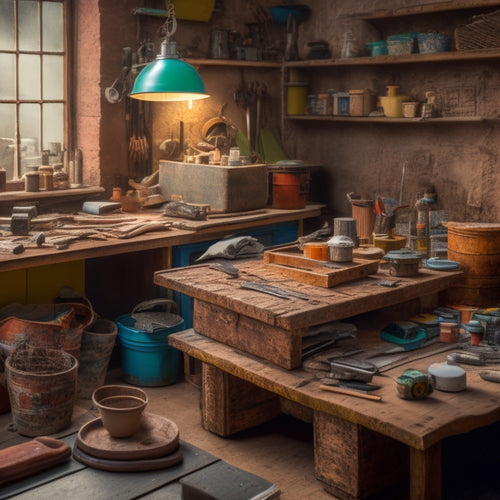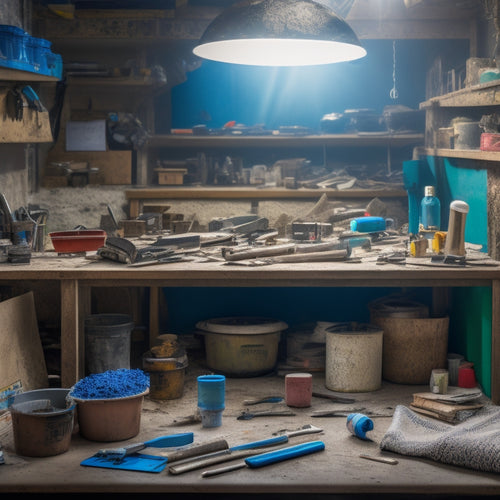
Estimate Tool Costs for Your Home Renovation
Share
When estimating tool costs for your home renovation's plastering job, you'll need to budget between $50 to $500 or more, depending on the scope, quality, and brand choices. Essential tools like trowels, joint knives, and mixing buckets can cost anywhere from $50 to $200, while high-end brands can exceed that. Additionally, you'll need to factor in costs for materials, surface preparation, and finishing requirements. To get an accurate estimate, consider the quality and quantity of tools needed, and allocate your budget accordingly. By understanding these factors, you'll be better equipped to plan and manage your tool expenses, and uncover more nuances that can make or break your project's success.
Key Takeaways
• Allocate 30-40% of your tool budget for trowels and accessories, and 40-50% for mixing and applying tools.
• Essential tools for plastering jobs, such as trowels and mixing buckets, can cost between $50 to $200 based on quality and brand.
• Tool quality and quantity depend on project scope and complexity, with high-end brands offering superior performance at higher costs.
• Accurately estimate additional tool expenses, including sanders, drills, and mixers, which can quickly add up if not carefully planned.
• Factor in hidden expenses like delivery fees and maintenance when calculating total tool costs for your home renovation.
Understanding DIY Plastering Costs
When tackling a DIY plastering project, you'll need to factor in the cost of essential tools, such as a plastering trowel, hawk, and joint knife, which can range from $50 to $200, depending on quality and brand.
However, tool costs are just the beginning. You'll also need to take into account the cost of materials, which can vary greatly depending on the type and quality of plaster you choose.
As you select your materials, think about the specific plastering techniques you'll be using, as some may require more or less material than others. For example, if you're using a scratch and brown coat method, you'll need more material than if you were using a single-coat application.
Additionally, the surface preparation and finishing requirements will also impact your material costs.
Essential Tools for Plastering Jobs
You'll need to assemble a core set of tools to tackle your plastering project, starting with a high-quality plastering trowel, which will be your go-to tool for applying and smoothing plaster. This trowel should have a sturdy handle and a rectangular or pointed blade, allowing you to scoop, spread, and finish plaster with ease.
Next, you'll need a joint knife or finishing knife for scraping and smoothing out joints and edges. A putty knife is also essential for filling small holes and imperfections. Don't forget a hawk or plastering board for holding and carrying plaster, and a mixing bucket and mixing stick for preparing the perfect plaster mix.
Mastering plastering techniques requires the right tools, and proper tool maintenance is vital to guarantee they last throughout your project. Regularly clean and dry your tools to prevent rust and corrosion. Store them in a dry, protected area to prevent damage.
Creating a Plastering Tool Budget
Creating a Plastering Tool Budget
Establishing a realistic budget for your plastering tools is essential to avoiding costly surprises and staying on track financially, as the quality and quantity of tools needed can vary greatly depending on the scope and complexity of your project. You'll need to take into account the specific tools required for your job, as well as the quality of those tools. High-end plastering tool brands like M-tec and Putzmeister may offer superior performance, but they come at a higher cost.
To plan your budget effectively, take into account the following strategies:
| Tool Category | Budget Allocation |
|---|---|
| Trowels and Accessories | 30-40% |
| Mixing and Applying Tools | 40-50% |
| Safety and Miscellaneous | 20-30% |
Estimating Trowel and Pan Costs
Precision is key when allocating funds for trowels and pans, as the quality and quantity of these essential tools can greatly impact the overall success of your plastering project.
You'll need to contemplate the type of trowel you require, as there are several options available. For instance, a pointed trowel is ideal for detailed work, while a square-notched trowel is better suited for larger areas. Additionally, you may need a finishing trowel for smoothing out the final layer of plaster.
When it comes to pans, you'll need to decide on the material that best suits your needs. Stainless steel pans are durable and easy to clean, while plastic pans are more affordable but may not last as long.
You may also think about a pan with a non-stick coating to prevent plaster from sticking to it. The size of your pan will also depend on the scale of your project, with larger pans suitable for bigger areas.
Calculating Additional Tool Expenses
Beyond trowels and pans, your plastering project requires a range of additional tools, whose costs can quickly add up if not carefully estimated. You'll need to evaluate the costs of sanders, drills, and mixers, as well as accessories like sandpaper, drill bits, and mixing paddles. These expenses can be substantial, especially if you're new to plastering and don't already have these tools in your arsenal.
To get an accurate estimate, break down your tool expenses into two categories: tools you'll need to purchase outright, and tools you can rent. Here's a rough guide to get you started:
| Tool | Purchase/Rental Cost |
|---|---|
| Electric sander | $50-$100 purchase, $20-$50 rental/day |
| Drill and mixing paddle | $30-$70 purchase, $10-$30 rental/day |
| Mixer | $100-$200 purchase, $50-$100 rental/day |
When calculating your tool expenses, don't forget to factor in hidden expenses like delivery fees, fuel costs, and any necessary maintenance or repairs. By evaluating all these factors, you can get a more accurate estimate of your total tool costs and avoid surprise expenses down the line.
Frequently Asked Questions
Can I Rent Tools Instead of Buying Them for My Renovation?
You're considering renting tools instead of buying them for your project. That's a smart move!
Tool rental benefits include reduced upfront costs and avoiding storage hassles.
Compare rental costs to buying prices to determine which option saves you more.
Factor in the frequency and duration of use, as well as maintenance and repair costs.
How Do I Account for Tool Maintenance and Repair Costs?
When calculating tool costs, you'll want to factor in maintenance and repair expenses to avoid surprise downtime.
Consider the tool's longevity and create maintenance schedules to extend its lifespan.
Set aside a budget for regular upkeep, like lubrication and sharpening, to prevent costly repairs.
Also, plan for unexpected repairs by allocating a contingency fund, ensuring you're prepared for any eventuality.
Are There Any Bundle Deals for Buying Multiple Tools at Once?
When buying tools, you're likely wondering if there are bundle deals for purchasing multiple tools at once.
The answer is yes! Many manufacturers offer bulk purchasing discounts or tool sets that can save you a pretty penny.
These sets often include a combination of essential tools, such as drills, saws, and wrenches, packaged together at a lower cost than buying individually.
Can I Use a Single Tool for Multiple Tasks in Plastering?
You're like a master chef, seeking to whip up a renovation masterpiece with the right tools.
When it comes to plastering, you're wondering if you can use a single tool for multiple tasks. The answer is yes!
Multi-tasking tools, like a hawk and trowel combo, can help you tackle various plastering techniques, such as applying, smoothing, and finishing.
Are There Any Eco-Friendly or Sustainable Tool Options Available?
You're looking for eco-friendly tool options that align with your values.
Fortunately, many brands now offer sustainable materials and innovative designs that reduce waste and minimize environmental impact.
Look for eco-friendly brands that use recycled materials, bioplastics, or sustainably sourced wood in their tools.
Some popular options include Hultafors, which uses recycled aluminum, and Stanley, which offers a line of eco-friendly hand tools made from sustainable materials.
You can make a positive impact with your tool choices.
Conclusion
You've made it to the final coat of your plastering journey!
With a solid understanding of the essential tools and costs, you're now equipped to tackle your home renovation like a pro.
Remember, estimating tool costs is a walk in the park compared to the mountain of savings you'll climb when you DIY.
By following these steps, you'll be swimming in a sea of savings, with enough left over to splurge on that fancy new kitchen backsplash you've been eyeing.
Happy renovating!
Related Posts
-

Budget-Friendly Materials for Your Home Renovation Project
As you plan your home renovation project, finding budget-friendly materials is key to turning your design vision into...
-

Why Do Cinder Block Wall Renovations Cost So Much
You're likely surprised by the high cost estimate for your cinder block wall renovation project, but it's driven by s...
-

Get Discounted Plastering Tool Sets for DIY Renovations
You can find discounted plastering tool sets online, at local hardware stores, and thrift stores, offering a range of...


